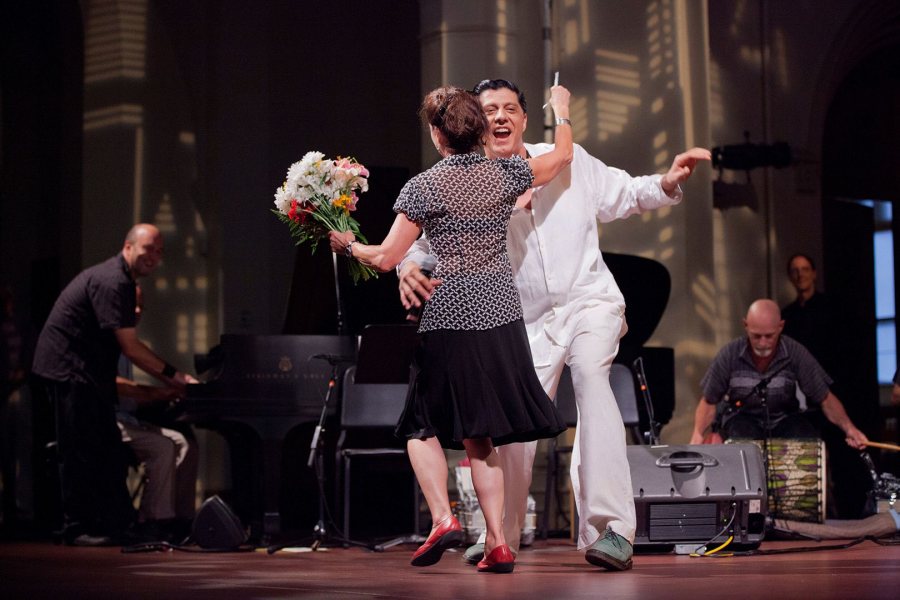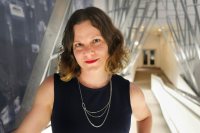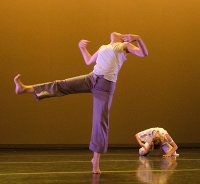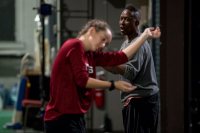
Laura Faure, Bates Dance Festival director, to step down after 2017 festival
Twenty-nine years, hundreds of performances, and countless classes after she arrived, the director of the Bates Dance Festival has announced plans to retire.
Laura Faure, the fourth director in the history of the festival, will step down after the 2017 season — the festival’s 35th and her 30th.
“Thirty years seems like a really good stretch,” says the 66-year-old Faure. “It just feels organically like the right time.”
Faure will turn over to her successor one of the nation’s leading dance festivals. During three decades at the helm, she has dramatically expanded the numbers of students, faculty-performers, and spectators attending the six-week festival. She has made the Bates Dance Festival an international presence.
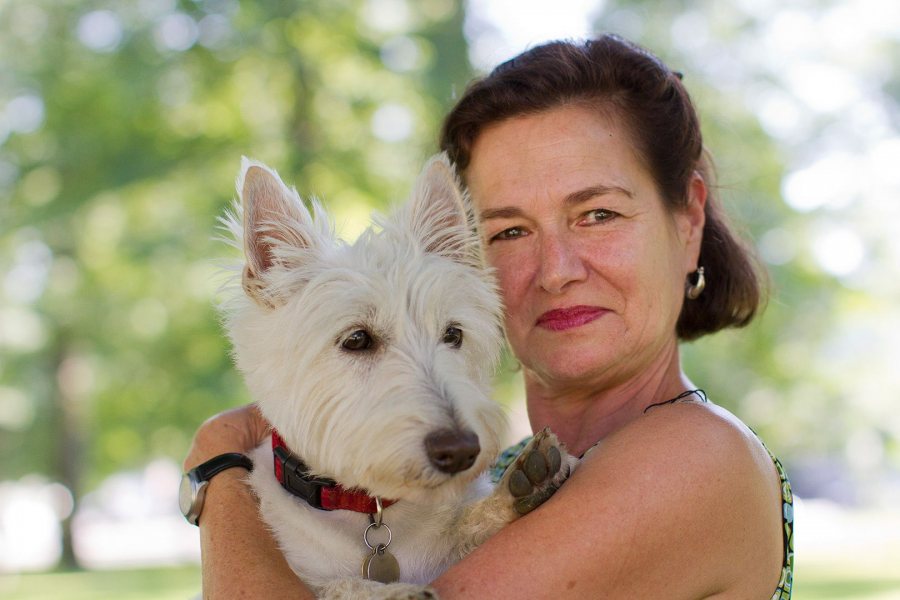
Laura Faure, director of the Bates Dance Festival, poses with Finn on the Bates campus in July 2012. (Phyllis Graber Jensen/Bates College)
She is at the center of a wide and robust network of dance artists, presenters, and funders. Her support, both material and moral, has enabled some of the nation’s most-respected choreographers to create groundbreaking work. In turn, many of those same artists have returned during the academic year to work with Bates students.
“We are indebted to Laura for her leadership of the Bates Dance Festival over the past 30 years,” says Bates President Clayton Spencer.
“The Bates Dance Festival has long stood for quality and innovation in dance education and dance-making. But the festival is also a force for good on many other levels. It has enriched and strengthened the college’s academic dance program, served as a powerful cultural engine for our region, and functioned as a wonderful ambassador for Bates in the larger world.”
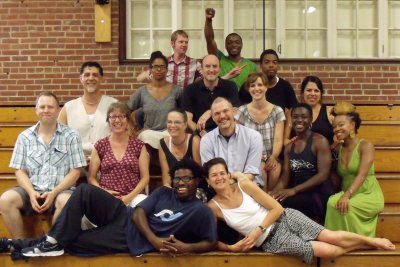
Laura Faure, front row at right, poses in Alumni Gym in July 2011 with members of the Bates Dance Festival’s Young Dancers Workshop faculty. (Bates Dance Festival)
National Endowment for the Arts peer review panels, says NEA Director of Dance Douglas Sonntag, “have consistently cited the value of the Bates Dance Festival to the overall health of the American dance field.
“The festival has been a longtime grantee of the NEA precisely because of the excellence it brings to the training of young dancers, the nurturing atmosphere it provides choreographers, and the performance opportunities it provides to a broad aesthetic range of dance companies.”
The late Marcy Plavin, creator of Bates’ academic dance program, launched the summer festival at the suggestion of the college’s then-president, Hedley Reynolds. The inaugural season in 1983 attracted 70 students and seven faculty-performers, and presented four performances by visiting artists.
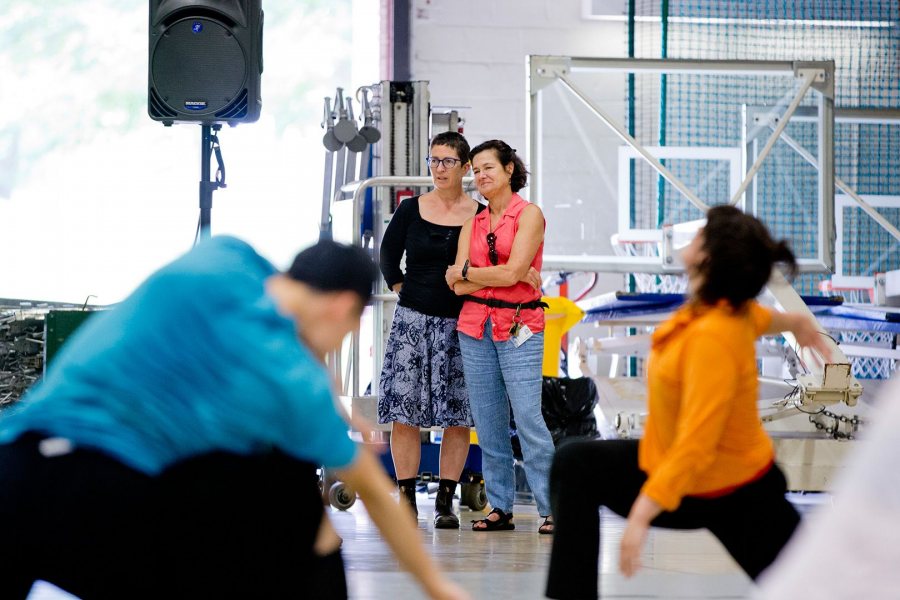
Professor of Dance Carol Dilley, left, and Bates Dance Festival Director Laura Faure observe the last minutes of a three-week modern dance class taught in 2015 by Omar Carrum in the Gray Athletic Building. (Phyllis Graber Jensen/Bates College)
That was a promising start. And by summer 2016, Faure was overseeing a teaching and performance operation involving 270 students; 93 faculty, performers, and visiting artists; and nine mainstage performances.
But the evolution of the Bates Dance Festival under Faure is about much more than numbers. And if you were to distill it to one word, that would be “community.”
One of Faure’s greatest accomplishments has been to build on a characteristic embodied by Plavin: a dedication to egalitarianism, collaboration, and mutual support, rather than competition.
“The performing arts world can feel competitive,” says Marlee Weinberg ’10, who attended three festivals as a student and three more as a counselor. “But at the Bates festival I never felt a competitive energy. It was all about the experience, all about learning, and expressing and facilitating creativity.”
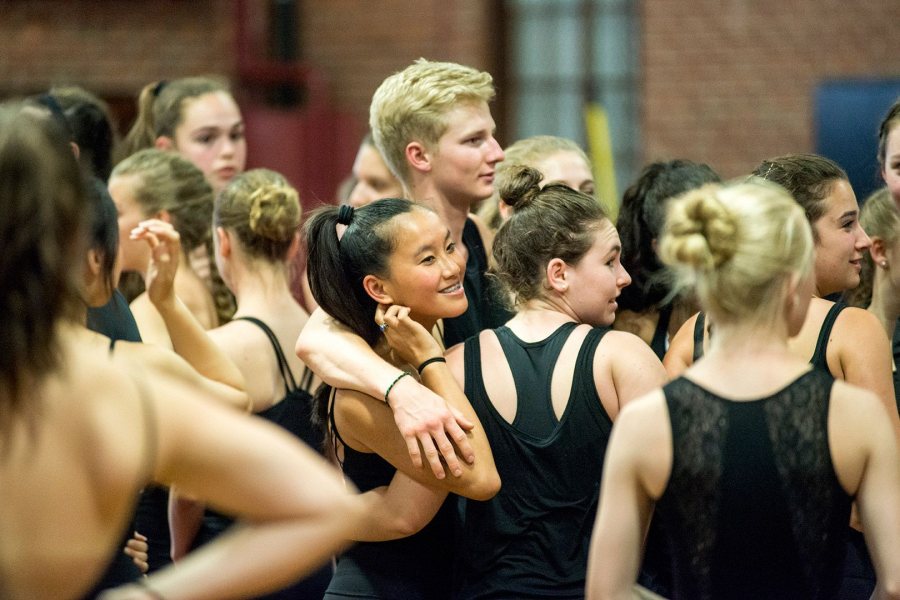
Bates Dance Festival students perform in a July 26 showcase in Alumni Gymnasium. (Josh Kuckens/Bates College)
“Laura has been extremely committed to that ethos,” says Suzanne Carbonneau ’76, a dance historian and critic, professor of performance at George Mason University, and longtime scholar-in-residence at the Bates festival. “That is something that she has never tried to change, and in fact has continued to deepen throughout her tenure.”
That ethos, Carbonneau adds, “is absolutely unique” among the so-called Big Three of American dance festivals — Jacobs Pillow and the American Dance Festival, in addition to Bates.
“She balances creating a festival as a presenter, as an educator, and as a supporter of artists,” says Associate Professor of Dance Rachel Boggia, who directs Bates’ academic-year dance program and has taken part in virtually every festival since 2005. “Those three things could be in tension, and she finds a way to bring them together.”
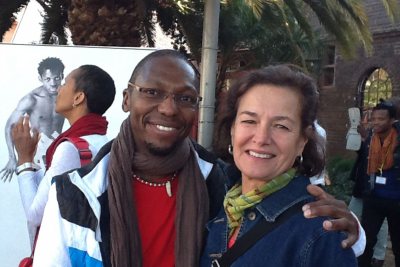
One of South Africa’s best-known choreographers and dancers, Vincent Mantsoe poses with Bates Dance Festival Director Laura Faure during one of her visits to Africa. Mantsoe has taken part several times in the festival’s International Visiting Artists Program. (Bates Dance Festival)
In short, Faure is a curator of community. Faure seeks out faculty and artists who are not only exceptional creators, performers, and teachers but, equally important, are also generous and caring, Boggia says.
“There’s always a dialogue going on,” Faure says. “I’ve always said that the festival has been a collective effort with really good ideas coming from here, there, and everywhere.”
And this exchange of ideas and experience continues outside class hours. The festival has a longtime custom of bringing students, visiting artists, and faculty together for every meal. And there’s a cherished tradition of front-porch conversations that go deep into the evening at the houses on Frye Street where performers and faculty stay.
“That’s where some of the most transformative learning happens,” Boggia says.
What strengths has Faure brought to the Bates Dance Festival? “She has incredible force of will,” Carbonneau says, coupled with great persuasiveness, resourcefulness, and ingenuity.
Moreover, “where other presenters look for the newest, shiniest, flavor-of-the-month art to burnish their reputations, Laura has committed to a long-term faith in a core group of artists,” she adds. “She has provided a kind of career-long support that seems all but impossible to find in the current cultural climate.”
Bebe Miller, Doug Varone, and David Dorfman are a few of the choreographers and company leaders who have returned repeatedly to the festival over the decades to teach, perform, and develop new work.
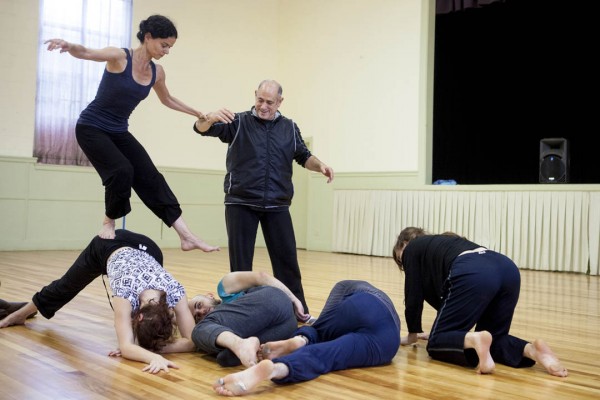
Choregrapher David Dorfman directs a rehearsal at Lewiston’s New Beginnings as part of a 2014 project featuring Dorfman’s company and dancers from Turkey and Armenia. Dorfman is a familar presence at the Bates Dance Festival. (Sarah Crosby/Bates College)
“They know that they have a home at Bates and that they will be supported over time,” Faure says. “They have a place to come and make work, and to teach, and to be with their peers.”
Festival support for artists includes programs for emerging choreographers and international visiting artists, as well as occasional commissions or co-commissions, such as Sean Dorsey’s “The Missing Generation,” which made its East Coast debut at the festival in 2015.
All told, the festival’s performance series has fostered the development and presentation of hundreds of new works, such as Rennie Harris’s “Rome & Jewels,” that have gone on to national and international acclaim.
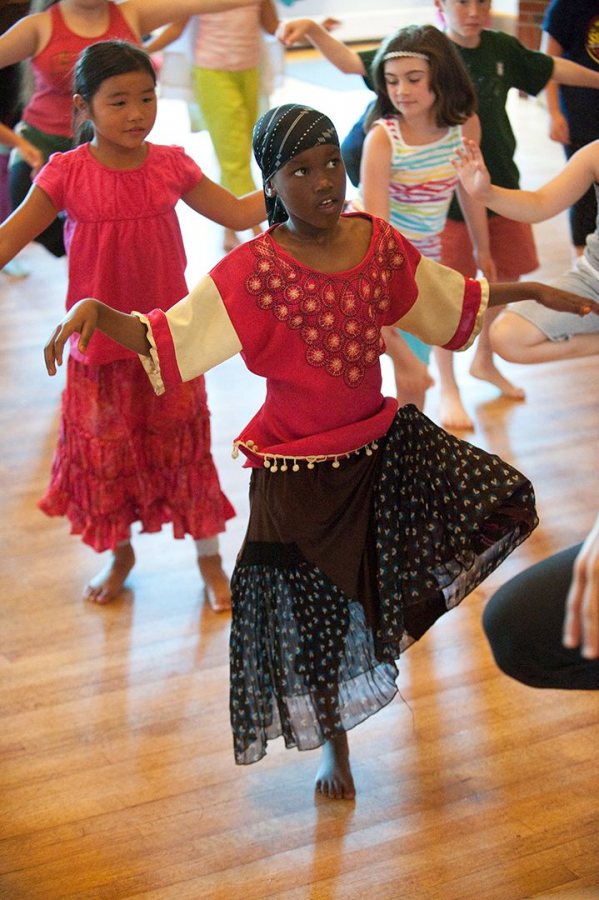
Youth Arts Program participants perform in the 2011 Bates Dance Festival. (Arthur Fink/Bates Dance Festival)
Some of the festival’s best-loved works have been major site-specific pieces that, pushing the creative possibilities to the edge, have introduced new ways of seeing familiar campus and local landmarks — such as a downtown Lewiston mill building (Varone’s 1992 “A Momentary Order”) and Bates’ own Lake Andrews (2007’s “Paradise Pond” by PearsonWidrig Dance Theater).
For adult dancers, the festival has offered a three-week professional training program since its inception. Faure added a second three-week workshop program for teenage dancers in 1996.
In 1993, she established the Youth Arts Program, a community outreach initiative that provides performing and visual arts classes to young people aged 7–16.
“Giving local young people access to artists of the caliber that we bring to the festival is, to me, a no-brainer,” Faure says. “If artists are coming to Lewiston, let’s get Lewiston kids involved.”
Faure has also walked the walk when it comes to diversity and inclusiveness at the festival, through scholarships and through assertive recruiting and network-building efforts at, for example, performing arts high schools in major cities.
The festival is a founding member of the Africa Contemporary Arts Consortium, a national program that promotes the exchange of arts and ideas between the U.S. and the African continent. That’s just one aspect of the festival’s international reach; Faure also travels extensively abroad, as well as in the U.S., to scout artists and recruit students.
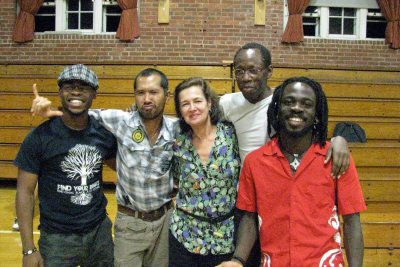
Laura Faure, center, is shown with members of the dance festival’s International Visiting Artists Program in 2009 in Bates’ Alumni Gym: from left, Nigerian artist Qudus Onikeku, Jose Jay B. Cruz of the Philippines, Faure, Opiyo Okach of Kenya and France, and Ivory Coast artist Michel Kouakou. (Bates Dance Festival)
Ultimately for Faure, though, dance is the vehicle for a higher end. “Laura has built a community for the dance world,” says Weinberg. “And I think that this community that she built is almost like a microcosm of the way Laura wishes the world to be. She has set up this festival that brings people together in a noncompetitive, open, creative setting.”
Faure says, “There’s something unique and very fundamental about dance as an art form: Because it deals with the body, it’s a form that never lies, because the body doesn’t lie. There’s something profoundly truthful and human about making art through the body, with the body.”
Long term, she expects to remain involved in dance, and the arts more generally, as a freelance consultant and curator. But immediately after the 2017 festival winds up, her top priority is some time off.
Although students, audiences, and esteemed modern dance artists attend the festival for just six weeks each summer, the director’s role is full time. “I’ve had deadlines every week all year round,” Faure says. “I’m ready to have a shift.”
She adds, “I am incredibly lucky. I’ve been appreciated in an overwhelming way by generations of students and artists because of what we’ve created. That is extraordinary and so rare.”
